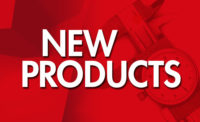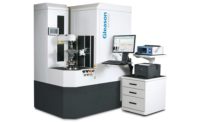Case Study
Multi-Sensor Machine Allows Two Measurements in One Setup
View in several directions.










Measuring injection molded parts from the top and from the side in one setup has been impossible for medical device manufacturer Balda Medical, Bad Oeynhausen, Germany, until now. Multisensor machines from Werth Messtechnik GmbH, Giessen, Germany, solve this problem with optical, tactile, and laser technologies. A special optical sensor head, mounted on a rotary/tilting adapter joint, allows the optics to measure from several directions.
Medical technology is a broad term, covering a multi-faceted field, from implants to various instruments to large medical equipment. This is the case for Balda Medical, Bad Oeynhausen, Germany. It specializes in plastic technologies, specifically in automated precision injection molding of mass produced parts.
Managing Director Dr. Rolf Eilers notes the company’s origins, which affected the choice of niche. “When Balda Medical was founded in 2003, the Balda Solutions company still belonged to the parent company, Balda AG. This was a shooting star in the German injection molding industry for mass production, rapidity, and surface technologies.” Mobile phone cases for every manufacturer were the main product. Because the company also had extensive expertise in moldmaking, the transfer of this existing knowledge to the medical field was a natural progression.
Balda Medical has concentrated since the beginning on subject areas in which production volumes are over 1 million, and that have high standards for design, surface technology, and precision. The initial products included, for example, a dry powder inhaler for asthmatics, and a lancing device for diabetics. Each of these articles consists of over 20 individual parts, some of which must fulfill challenging functions, and must therefore be dimensionally correct.
Dr. Eilers sees the company today as a system partner in B2B. “We have our own product development department. Concepts for complete products are created there, even if they will never bear the name of Balda.” The company builds models and functional prototypes, and qualifies the associated machines and molds. The processes are then validated, so that the safety and function of the components, and the devices and systems made from them, are ensured, and this quality is documented for traceability.
No Development without Measurement Technology
From development to production, measurement technology is an important part of the process chain. The requirements for an article, such as a lancing device, are stringent. The 20 or more individual components must work together when assembled. The tolerance chains to be met across several components are in the range of a few hundredths of a millimeter.
Fast, reliable measurements are also needed to improve production processes. Later, when the articles are produced in series, complete documentation is required to respond to returns if needed. Thus, there is no getting around an appropriately equipped and staffed measurement technology department. This was set up at Balda Solutions in the early years. Since the turn of the year 2007/2008, the former measurement technology group at Balda, including all personnel and machines, belongs to Balda Medical.
Thorsten Rabeneck has been working in measurement technology at Balda since 2001. Since mid-2008, he has managed this department, which also has three additional experienced employees. Three VideoCheck IP 600 multisensor coordinate measuring machines from Werth Messtechnik, Giessen, are located in his measurement room. They are gantry machines, with solid granite bases and air bearings and extensive sensors, tactile touch and scanning probes, and the laser sensor. They are used primarily for initial sample preparation for injection molded parts and for corrective and special measures. Two additional measuring machines are located in production, for series inspection, or In-Process Control (IPC). They are managed by the measurement technology department, which also generates the individual measurement programs. They are operated in production by trained personnel.
Holger Zastrow, Quality Assurance Manager, whose department includes the areas of measurement technology, quality inspection, and quality planning, says, “The responsibilities in the quality assurance area are always in flux. Measurement technology, with its high-value measuring machines, takes on mainly analytical tasks.” This includes standards, such as measuring against a drawing, for creating initial sample inspection reports.
Systematic measurement during series production belongs to production, to a degree. The IPC data generated there are automatically maintained in the CAQ system for evaluation. If problems are found – in the tolerance chain analysis, for example – that cannot be accounted for at first glance, measurement technology is used once again. By using lab tests and subsequent measurements, the employees work together to track down the error.
One Hundred Percent Reproducible Measurement Results
When selecting measuring machines, Balda decided on Werth Messtechnik back in 1998. The VideoCheck IP 600 multisensor coordinate measuring machine proved to be ideal for measuring mobile phone cases, so that additional machines were obtained in 2001 and 2004. In Thorsten Rabeneck’s experience, “These measuring machines are very reliable, and the results are 100% reproducible. They are also very fast, and simple to operate and to program.”
The close contact with the specialists at Werth, who continuously develop their technology and take on new challenges openly and without hesitation, was well received by the entire Balda measurement technology team. Werth Messtechnik and Balda have kept all three VideoCheck machines updated with the latest level of development. For example, one machine was upgraded with a laser line sensor and a rotary axis to be more effective, particularly with regard to multi-point measurements that are compared to CAD data.Refitting the IP40 Werth sensor (Figure 1) brought a particular advantage, a tiltable optic (see Sidebar).
The impetus was a housing that was difficult to measure. The measurements must be taken optically, in the vertical plan view, while the reference can be measured optically only from the side. The part was previously measured in several orientations, changing over constantly with multiple setups, which led to imprecision. Only with the tiltable optic is a single setup possible for reliably addressing the measurement task and obtaining reproducible measurement results.
For some parts, dimensions need to be captured that cannot be achieved either with classical optics or classical tactile measurement. A 3D STL data set is now generated using the laser line sensor, and is then evaluated against 3D CAD data (Figure 2).
This takes place in the WinWerth 3D CAD software module. The STL data is overlaid on the prescribed 3D CAD data set (nominal data) and automatically adjusted to fit (Figure 3).
Individual dimensions can also be extracted and section planes can be shown. Deviations are marked in color and can be seen at a glance. This color-coded presentation of deviations is required, for example, for the initial sample inspection report, to complement the typical Excel evaluation.
For complex components, or multi-component systems, Balda Medical is turning more and more to the special capabilities of a TomoScope x-ray system. The associated 3D STL data sets are generated by external metrology service companies, then processed and evaluated in the Balda Medical measurement technology department using the WinWerth 3D CAD module. The broad spectrum and rapidity of Werth Messtechnik, and the team’s extensive experience in component measurement, have decisive advantages in information, time, and costs for Balda Medical as well as for external clients.
Fast and FlexibleWith the IP40 T sensor, Werth Messtechnik, Giessen, covers flexible measurement with image processing and rotary/tilting joints, even for large coordinate measuring machines. The compact sensor head with telecentric optics is mounted, using the automatic changeout interface, on the PH6M probe holder, the PH10M rotary/tilting joint, and the PHS1 servo rotary/tilting head from Renishaw. It can be exchanged for a touch trigger or scanning probe system. Bright field incident illumination is integrated in the beam path. The 8-quadrant dark field incident illumination provides the ability to control the illumination direction. Using changeout kinematics, the light ring can be exchanged for a 3D fiber probe, allowing contact measurements of very small geometries with the lowest possible contact forces. The laser line sensor LLP, according to Werth Messtechnik, allows extremely rapid scanning of 3D workpieces with high point density. High precision of the measurement data is achieved, even for shiny and strongly absorbent surfaces, without prior coating with paint or other material. Integration in the Werth Multisensor concept also makes it possible to check parts using the line sensor in combination with other sensors (optics, probe). |
Werth, Inc.
8 Custom Drive
Old Saybrook, CT 06475
www.werthinc.com
(860) 399-2445
Looking for a reprint of this article?
From high-res PDFs to custom plaques, order your copy today!













